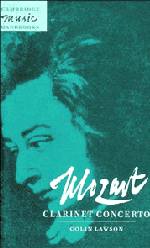Book contents
- Frontmatter
- Contents
- List of illustrations
- Preface
- 1 The eighteenth-century clarinet and its music
- 2 Mozart, Stadler and the clarinet
- 3 The genesis and reception of the Concerto
- 4 Stadler's clarinet and its revival
- 5 Mozart's original text
- 6 Design and structure
- 7 Performance practice
- Appendix 1 A review of the Breitkopf and Härtel edition in the Leipzig Allgemeine Musikalische Zeitung, 4 (March 1802)
- Appendix 2 Surviving instruments
- Appendix 3 A list of works composed by Mozart's clarinettist, Anton Stadler
- Notes
- Select bibliography
- Index
Appendix 2 - Surviving instruments
Published online by Cambridge University Press: 05 June 2012
- Frontmatter
- Contents
- List of illustrations
- Preface
- 1 The eighteenth-century clarinet and its music
- 2 Mozart, Stadler and the clarinet
- 3 The genesis and reception of the Concerto
- 4 Stadler's clarinet and its revival
- 5 Mozart's original text
- 6 Design and structure
- 7 Performance practice
- Appendix 1 A review of the Breitkopf and Härtel edition in the Leipzig Allgemeine Musikalische Zeitung, 4 (March 1802)
- Appendix 2 Surviving instruments
- Appendix 3 A list of works composed by Mozart's clarinettist, Anton Stadler
- Notes
- Select bibliography
- Index
Summary
A list of clarinets and basset horns relevant in design and provenance to the study of Mozart's Clarinet Concerto, compiled for this appendix by Nicholas Shackleton.
[Y] numbers refer to Phillip T. Young, 4900 Historical Woodwind Instruments: An Inventory of 200 makers in International Collections (London, 1993); see also makers' entries in William Waterhouse, The New Langwill Index: A Dictionary of Musical Wind-instrument Makers and Inventors (London, 1993).
Basset clarinets
Basset clarinets were first made during the late eighteenth century to a variety of designs, pitched in the keys of Bl>, A and C. Their distinguishing feature from normal clarinets is the addition of lower notes below the usual written bottom note e, as on basset horns of the period. Table 1 lists clarinets that by any stretch might be called basset clarinets. The first three probably date from the 1770s, and illustrate the fact that extended clarinets existed before Stadler's time. No. 1 is sickle-shaped like the basset horns by the same maker. Nos. 2 and 3 are a pair with curved brass crooks and straight bodies. These three descend to low c but without the intervening d. No. 4 is curved but unlike No. 1 the body is made of curved pieces of boxwood joined together, each piece being cylindrically bored; this method would be capable of making a more precise bore than the method used to make No. 1.
- Type
- Chapter
- Information
- Mozart: Clarinet Concerto , pp. 84 - 90Publisher: Cambridge University PressPrint publication year: 1996

